Air University (United States Air Force)
| The Air University | |
|---|---|
 Emblem of Air University 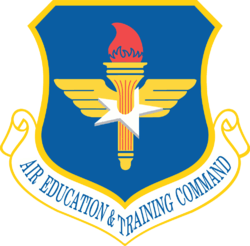 Part of Air Education and Training Command | |
| Active | 1920–1942; 1943 – present |
| Country | United States of America |
| Branch | United States Air Force |
| Type | Professional Military Education |
| Commanders | |
| Current commander | Lt Gen Anthony J. Cotton[1] |
| Notable commanders | Muir S. Fairchild |
The Air University (AU), headquartered at Maxwell Air Force Base, Alabama, is a key component of the Air Education and Training Command (AETC), and is the U.S. Air Force's center for professional military education (PME).[2]
Organizations
- Air Force Institute of Technology (AFIT)
- Carl A. Spaatz Center for Officer Education
- Air War College[3] (AWC)
- Air Command and Staff College (ACSC)
- Squadron Officer School (SOS)
- International Officers School[4] (IOS)
- School of Advanced Air and Space Studies (SAASS)
- USAF Counterproliferation Center
- Curtis E. Lemay Center for Doctrine Development & Education[5]
- Ira C. Eaker College for Professional Development
- Air Force Chaplain Corps College
- Air Force Personnel Professional Development School
- Commanders' Professional Development School
- Defense Financial Management & Comptroller School
- National Security Space Institute
- Jeanne M. Holm Center for Officer Accessions and Citizen Development
- Air Force Officer Training School (OTS)
- Air Force Reserve Officer Training Corps (AFROTC)
- Air Force Junior Reserve Officer Training Corps (AFJROTC)
- Civil Air Patrol (CAP)
- Civilian Acculturation and Leadership Training (CALT)
- Thomas N. Barnes Center for Enlisted Education
- Airman Leadership School (ALS)
- Air Force Career Development Academy
- Air Force Enlisted Heritage Research Institute (AFEHRI)
- Air Force Senior Noncommissioned Officer Academy (SNCOA)
- Air Force Noncommissioned Officer Academy (NCOA)
- Enlisted Professional Military Education Instructor Course (EPMEIC)
- Chief Master Sergeant Leadership Course (CLC)
- Community College of the Air Force (CCAF)
- USAF First Sergeant Academy (FSA)
- USAF Center for Counterproliferation Studies[6]
- Air Force Research Institute[7] (AFRI)
- Air Force Fellows Program[8] (AFF)
- Air Force Historical Research Agency (AFHRA)
Schools and Centers
The institutions that fall under The Air University include:
Officer Professional Military Education
The Carl A. Spaatz Center for Officer Education (Spaatz Center) unifies the continuum of Air Force officer professional military education. Activated on 29 Apr 2008, the Spaatz Center is named in honor of the Air Force's first Chief of Staff, General Carl A. Spaatz. The Spaatz Center remains committed to being the global leader in officer education by developing leaders, spurring innovation, and nurturing partnerships to advance air power.
- Squadron Officer College

Squadron Officer College (SOC) was a short-lived successor to the previous legacy twelve-week and the current 6.5-week Squadron Officer School (SOS).
SOC was a shortened five-week version of the previously conducted twelve-week SOS for 1st Lieutenants and Captains. SOC was based on the premise that all newly commissioned USAF 2d Lieutenants from all officer accession sources (e.g., USAFA, AFROTC, OTS, etc.) would attend the since-discontinued six-week Air and Space Basic Course (ASBC) at Maxwell AFB as 2d Lieutenants prior to reporting to their initial duty assignments. Under the ASBC/SOC construct, these same officers would return to Maxwell AFB three to four years later as Captains in order to complete the five-week SOC course as a temporary duty (TDY) assignment in residence.
SOC's mission was to develop company grade officers as leaders of integrity, ready, willing and able to overcome the challenges of today’s complex security environment. SOC and its successor, the since-reinstated eight-week Squadron Officer School (SOS), provided/provides a professional military education experience devoted to junior officer leadership development. SOC was open to all active duty Regular Air Force, Air Force Reserve and Air National Guard Captains (O-3), their international counterparts, and civilian equivalents.
SOC was disestablished on 28 June 2011 when SOS was reestablished.
- Squadron Officer School
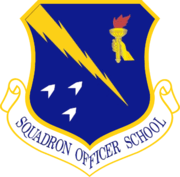
With the disestablishment of SOC on 28 June 2011 by the Chief of Staff of the Air Force and the announcement that ASBC would be eliminated, Squadron Officer School (SOS) was reinstated back to its original duration as an eight-week resident program at Maxwell AFB. In 2017, it was restructured as a 6.5 week program. The goal is 100% opportunity for in-residence attendance by all active duty USAF and most Air Reserve Component (e.g., Air Force Reserve and Air National Guard) Captains. The SOS distance learning program will remain to provide a method to complete Base Development Education (BDE) for those officers whose situation, primarily those in the Air Reserve Component, precludes them from attending SOS in residence.
- Air Command and Staff College

Air Command and Staff College (ACSC) is a 10-month master’s level resident program that prepares field grade USAF, U.S. Army and USMC officers in pay grade O-4 and USN / USCG officers in pay grade O-4, their international counterparts, and U.S. civilian equivalents, for positions of higher responsibility within the military and other government agencies. Often referred to as "Intermediate Level Education" (ILE), Intermediate Level Professional Military Education (Intermediate Level PME) or Phase I Joint PME, ACSC is also available via "distance learning," primarily a CD-ROM enabled correspondence course.
- Air War College

Air War College (AWC) is a 10-month resident course for USAF, U.S. Army and USMC Lieutenant Colonels and Colonels (pay grades O-5 and O-6), USN and USCG Commanders and Captains (pay grade O-5 and O-6), their international counterparts, and Department of Defense and Department of the Air Force civilian equivalents (GS-14/GM-14, GS-15/GM-15). AWC prepares students to lead in a joint, interagency and multi-national environment at the strategic level of military operations. Also known as "Senior Developmental Education" (SDE), Senior Level PME, or (since 2010) Phase II JPME, AWC is also available at the Pentagon and selected active USAF installations as a 10-month seminar program paralleling the academic year and course content of the resident course. It is also available via "distance learning" as a correspondence course typically requiring 18 to 24 months to complete.
The Secretary of the Air Force's annual National Security Forum (NSF) conducted for select influential civilian leaders in business, industry, state and local government, law, academia, media, and the clergy is administered and hosted by the AWC.
- International Officer School
The International Officer School (IOS) is a seven-week course designed to provide international officers an enhanced understanding of the United States and prepares them for attending Squadron Officer School, Air Command and Staff College, and/or the Air War College.
Enlisted Professional Military Education

The Thomas N. Barnes Center for Enlisted Education (Barnes Center, formerly the College for Enlisted Professional Military Education) is responsible for the instructional programs and faculty development for all Air Force enlisted professional military education programs. This includes the Airman Leadership Schools, Noncommissioned Officer Academies and the Air Force Senior Noncommissioned Officer Academy.
- Air Force Senior Noncommissioned Officer Academy
The Air Force Senior Noncommissioned Officer Academy graduates more than 1,800 Air Force chief master sergeant selectees, senior master sergeants, senior master sergeant selectees, and non-commissioned officers and chief petty officers from other U.S. military services and the services of international U.S.-Allied nations annually. It is located on Maxwell AFB's Gunter Annex.
- NCO Academies
The NCO Academies provide selected noncommissioned officers quality professional military education to develop their skills and responsibilities in the United States Air Force. The objective is for the students to gain an understanding of their positions in the military structure and the need to develop the skills necessary for effectiveness in those supervisory positions. Several NCO Academies operate worldwide on various Air Force installations.
- Airman Leadership School
The mission of Airman Leadership School is to prepare Air Force personnel in the rank of senior airmen for supervisory duties and foster a commitment to the profession of arms. The goal of the program is to provide senior airmen an opportunity to understand more fully their position in the USAF organizational structure and the continued need for professional development to be effective NCOs.
- First Sergeant Academy
The First Sergeant Academy's mission is to develop through education and training selected senior noncommissioned officers to serve as advisors to commanders on issues that impact our Airmen in successfully accomplishing our Air Force mission. The academy's vision is to execute a standardized, state-of-the-art program to maximize first sergeant's capabilities and develop enlisted leaders for the United States Air Force.
- Enlisted Heritage Research Institute
The Enlisted Heritage Research Institute is dedicated to preserving the rich and dramatic heritage and tradition of the enlisted corps of the U.S. Air Force and U.S. Army Aeronautical Division, Air Service, Air Corps and Air Forces in the development of air power to defend the United States. The Institute achieves this by featuring artifacts, collections, and pictorial exhibits, written and oral documentation, audiovisuals, equipment, and selected aircraft parts. Additionally, students use the in-house and on-line research capabilities to enhance learning and complete enlisted heritage research projects.
Officer Accessions
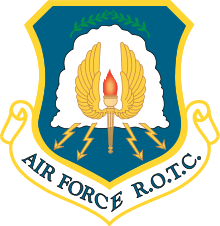
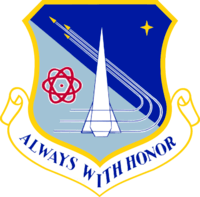
The Jeanne M. Holm Center for Officer Accessions and Citizen Development (Holm Center), previously known as Air Force Officer Accession and Training Schools (AFOATS), operates two of the four USAF officer commissioning sources. These are the Air Force Reserve Officer Training Corps (AFROTC) at civilian colleges and universities across the United States, and the Air Force Officer Training School (OTS) at Maxwell AFB.
Although they are USAF officer accession and training programs, the United States Air Force Academy (USAFA) and the Air National Guard's Academy of Military Science (AMS) do not fall under the Air University. The U.S. Air Force Academy is a Direct Reporting Unit (DRU), and the Superintendent of the USAF Academy reports directly to the Chief of Staff of the Air Force. Admission to and administration of the ANG Academy of Military Science, although collocated with OTS at Maxwell AFB, is controlled by the Director of the Air National Guard via the National Guard Bureau (NGB).
Citizenship Development, Aerospace Education, and Associated Programs

Through the Holm Center, the Air University also administers two additional programs.
Air Force Junior Reserve Officer Training Corps
The Air Force Junior Reserve Officer Training Corps (AFJROTC) program provides citizenship training and air and space science education via a cadet program for high school students in grades 9 through 12 at various high schools across the United States and at select Department of Defense Dependent Schools (DoDDS) at US military installations overseas. Instruction is conducted by retired field grade USAF officers employed by the respective school systems, assisted by retired USAF senior non-commissioned officers under similar employment.[9]
AFJROTC is a "citizenship program" for high school students and should not be confused with AFROTC, which is a "pre-commissioning program" for 4-year college and university students to become Air Force officers.[10]
Civil Air Patrol

The Air University is also the command echelon equivalent to a numbered air force for the Civil Air Patrol (CAP). CAP is a private, corporately chartered, civilian non-profit organization headquartered at Maxwell AFB and concurrently designated as the U.S. Air Force Auxiliary (USAF Aux). CAP is sponsored by the Air Force and considered part of the Total Force of the U.S. Air Force, but it is a strictly civilian entity and not an operating Air Reserve Component (ARC) like the Air Force Reserve Command or the Air National Guard.[11]
Under its congressionally assigned missions, CAP provides a fleet of light general aviation fixed-wing aircraft, multipurpose ground vehicles, ground support units, communications support units and trained adult members with a USAF-style rank structure available in support of domestic search and rescue, disaster relief, other emergency services, and homeland defense/homeland security activities.[11]
CAP also conducts an aerospace education for youth and the general public and operates a cadet program similar to the AFJROTC program, but with a wider age distribution ranging from middle school/junior high school through high school. Cadets can optionally retain their cadet status through undergraduate college or university (to include the service academies), or they may opt to transfer to senior member status between ages 18 and 21. As a result, CAP cadets range in age from 10 1/2 to just prior to their 21st birthday.[12]
The CAP program is established as an organization by Title 10 of the United States Code and its purposes defined by Title 36 USC. CAP is commanded by a Civil Air Patrol major general, functioning as a full-time employee of the CAP corporation at Maxwell AFB, overseeing 52 wings assigned to each state, Puerto Rico and the District of Columbia. The CAP commander is supported by an active duty aeronautically rated USAF colonel as the senior USAF-CAP Advisor. Air University oversight of CAP is delegated to the Holm Center.
Academic education
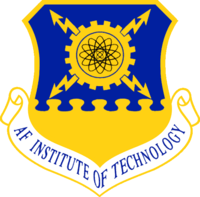
The Air Force Institute of Technology (AFIT) is a geographically separated unit (GSU) of Air University, located at Wright-Patterson AFB, Ohio. AFIT supports the Air Force and national defense through responsive degree-granting postgraduate and professional continuing education, research and consulting services to Air Force and Department of Defense agencies. Graduate-level work offers selected Air Force officers, Air Force civilians, and international officers the broad educational experience necessary for understanding the role of technology in national defense and in analyzing and solving defense-related problems.
The Community College of the Air Force (CCAF) is the only degree-granting institution of higher learning in the world dedicated exclusively to enlisted military personnel. CCAF offers educational opportunities for active duty, Air National Guard and Air Force Reserve airmen and NCOs to earn a job-related, two-year undergraduate associate of applied science degree. CCAF also facilitates selected professional certification and recognition for airmen. Possession of a CCAF degree has in recent years become a de facto mandatory requirement for promotion to Senior Master Sergeant and higher, regardless of whether or not the candidate has a civilian degree such as a baccalaureate. This de facto status is now official: starting with the 2007 promotion cycle, promotion candidates cannot receive critical endorsements on performance reports without having first received an associate degree from CCAF.
Professional continuing education
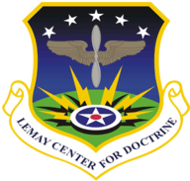
The Curtis E. LeMay Center for Doctrine Development and Education (LeMay Center), previously known as the Air Force Doctrine Development and Education Center, develops and publishes Air Force doctrine, teaches doctrine through resident and on-line courses, and advocates air power through visionary war gaming, and provides Integration and outreach services for Air University.
The Ira C. Eaker College for Professional Development provides continuing education and technical training to Air Force and other Department of Defense personnel and international officers, including resident and distance-learning courses for a variety of Air Force specialties.
United States Air Force Center for Unconventional Weapons Studies
The USAF Counterproliferation Center was established in 1998 at the direction of the Chief of Staff of the Air Force. Located at Maxwell AFB, this Center capitalizes on the resident expertise of Air University, while extending its reach far beyond - and influences a wide audience of leaders and policy makers. A memorandum of agreement between the Air Staff Director for Nuclear and Counterproliferation (then AF/XON), now AF/A5XP) and Air War College Commandant established the initial manpower and responsibilities of the Center. This included integrating counterproliferation awareness into the curriculum and ongoing research at the Air University; establishing an information repository to promote research on counterproliferation and nonproliferation issues; and directing research on the various topics associated with counterproliferation and nonproliferation .
The Secretary of Defense's Task Force on Nuclear Weapons Management released a report in 2008 that recommended "Air Force personnel connected to the nuclear mission be required to take a professional military education (PME) course on national, defense, and Air Force concepts for deterrence and defense."
In 2011, the Air Force added four teaching positions to the Air War College to enhance nuclear PME efforts. At the same time, the Air Force Nuclear Weapons Center, in coordination with the AF/A10 and Air Force Global Strike Command, established a series of courses at Kirtland AFB to provide professional continuing education (PCE) through the careers of those Air Force personnel working in or supporting the nuclear enterprise. This mission was transferred to the Counterproliferation Center in 2012, broadening its mandate to providing education and research on not just countering WMD but also nuclear operations issues. In April 2016, the nuclear PCE courses were transferred from the Air War College to the U.S. Air Force Institute for Technology.
In February 2014, the Center’s name was changed to the Center for Unconventional Weapons Studies to reflect its broad coverage of unconventional weapons issues, both offensive and defensive, across the six joint operating concepts (deterrence operations, cooperative security, major combat operations, irregular warfare, stability operations, and homeland security). The term “unconventional weapons,” currently defined as nuclear, biological, and chemical weapons, also includes the improvised use of chemical, biological, and radiological hazards.
The CUWS's military insignia displays the symbols of nuclear, biological, and chemical hazards. The arrows above the hazards represent the four aspects of counterproliferation - counterforce, active defense, passive defense, and consequence management. The Latin inscription "Armis Bella Venenis Geri" stands for "weapons of war involving poisons."[13]
Advanced Professional Military Education
The School of Advanced Air and Space Studies (SAASS) is the U.S. Air Force's postgraduate school for air power, space power and cyber power strategists. A highly qualified and motivated faculty, a small and very carefully selected student body, a coherent and challenging curriculum, an outstanding educational and research resources, and a well-designed facility combine to produce tomorrow's senior military leaders who are experts in the employment of air, space and cyberspace forces. SAASS is a follow-on school for selected USAF graduates of intermediate-level professional military education schools. The focus of SAASS is to educate officers in the art and science of air, space and cyberspace warfare to enhance the Air Force's capacity to defend the United States through the control and exploitation of air, space and cyberspace.
Associated Agencies
Air Force Historical Research Agency

The Air Force Historical Research Agency is the repository for United States Air Force historical documents.
The Agency's collection, begun during World War II in Washington, DC, moved in 1949 to Maxwell Air Force Base, the site of the present-day Air University, to provide research facilities for professional military education students, the faculty, visiting scholars, and the general public.
History
Lineage
- Authorized as the Air Service School by the War Department on 25 February 1920, and established that same year, exact date unknown
- Redesignated: Air Service Field Officers' School on 10 February 1921
- Redesignated: Air Service Tactical School on 8 November 1922
- Redesignated: Air Corps Tactical School on 18 August 1926
- Discontinued on 9 October 1942
- Established as: Army Air Forces School of Applied Tactics, 16 Oct 1942
- History and insignia of Air Corps Tactical School bestowed upon activation.
- Redesignated as: Army Air Forces School on 1 June 1945
- Established as Major Command: 29 November 1945
- Redesignated as: Air University on 12 March 1946
- Reassigned to Air Training Command on 15 May 1978, losing major command status
- Returned to major command status effective 1 July 1983
- Changed from a major command of the United States Air Force to a subordinate organization of Air Education and Training Command on 1 July 1993.
Stations
- Langley Field, Virginia, 25 Feb 1920 - 14 Jul 1931
- Maxwell Field, Alabama, 15 Jul 1931 – 9 Oct 1942
- Orlando Army Air Base, Florida, 16 Oct 1942 - 29 Nov 1945
- Maxwell Field (later Maxwell AFB), Alabama, 29 Nov 1945 – Present
Components
During the years 1943–1945, the Army Air Forces School of Applied Tactics (AAFSAT) at Orlando Army Air Base, Florida operated a massive air-to-air and air-to-ground combat simulation facility across Central Florida. Units and various main operating bases and auxiliary airfields were established throughout an 8,000-square-mile (21,000 km2) area of central Florida designated as a mock "war theater" and stretching roughly from Tampa through Orlando, east to Titusville, north to Starke, and northwest to Apalachicola in which air war games were conducted. Following the end of World War II, the simulation facility ceased operation and most of the operating air bases and auxiliary airfields were either placed in military caretaker status or returned to local civilian control. On 1 Jun 1945, the AAFSAT was redesignated as the Army Air Forces School (AAFS). On 29 Nov 1945, the AAFS relocated from Orlando AAB, Florida to Maxwell Field, Alabama.
Operations
The Wright Brothers established the first U.S. civilian flying school in Montgomery, Alabama in 1910. By the 1920s, Montgomery became an important link in the growing system of aerial mail service. It was in the early 1930s when the Army Air Corps Tactical School moved to Maxwell Field and Montgomery became the country's intellectual center for airpower education.
Air University (AU), established in 1946, continues the proud tradition of educating tomorrow's planners and leaders in air and space power for both the U.S. Air Force as well as other branches of the U.S. Armed Forces, federal government civilians and many international organizations. Today, AU has a reach worldwide affecting the careers of every member of the United States Air Force.
Origins
As a result of the US Army Reorganization Act of 1920, the Air Service authorized the establishment of an Air Service School on 10 February 1921 at Langley Field, Virginia. To reflect its primary mission of preparing senior officers for higher Air Service duty, the Air Service redesignated the Air Service School as the Air Service Field Officers' School.
Following the decision to let all Air Service officers attend the institution in 1922, the Air Service redesignated the Air Service Field Officers' School as the Air Service Tactical School. In conjunction with the 1926 redesignation of the Army Air Service as the Army Air Corps, the Air Service Tactical School became the Air Corps Tactical School. To take advantage of the propitious climate and facilities expansion potential, the Army Air Corps began moving the Air Corps Tactical School from Langley Field in Virginia in 1931 to Maxwell Field, Alabama.
World War II
Because of the wartime need for officers of the caliber of those attending the Maxwell institution, in May 1941 the Army Air Corps suspended instruction at the tactical school and reduced its faculty and staff to seven officers. Anticipating the institution's eventual reopening, the Army Air Corps moved the skeletonized Air Corps Tactical School to Washington, DC, and placed it under the Directorate of Individual Training. In spite of the institution's successful efforts in developing Air Corps planners and leaders, the Air Corps discontinued the Air Corps Tactical School on 9 October 1942 with the intention of reopening it after the war.
To partially fill the educational void left by the discontinuance of the Tactical School and to correct the growing shortage of experienced Air Corps, later renamed Army Air Forces, officers, the Army Air Forces authorized the establishment of the Army Air Forces School of Applied Tactics on 9 Oct 42. The Army Air Forces activated the AAF School of Applied Tactics at Orlando Army Air Base, Florida, with the mission to train "selected officers" under simulated combat conditions. Based on lessons learned in the combat theaters and the school's actual operational experiences, the AAF established the AAF Tactical Center with the AAF School of Applied Tactics as a subordinate unit. Due to a major reorganization of the Tactical Center and a change in the types of courses conducted by the institution, the Army Air Forces redesignated the AAF School of Applied Tactics as the Army Air Forces School on 1 Jun 45.
Postwar era
In preparation for its post-war educational operations, the Army Air Forces transferred the Army Air Forces School from Orlando AAB to Maxwell Field, Alabama on 29 November 1945 and assigned it directly to Headquarters, U.S. Army Air Forces (HQ AAF) as a major command.
In the first conclave of its kind since the end of World War II, the AAF Educational Conference ended after a three-day meeting on 20 Feb 1945 to discuss the post-war AAF educational structure. The Army Air Forces began the first instructor training course in March 1946 for preparing instructors to teach at the post-war AAF educational institutions.
HQ AAF redesignated the Army Air Forces School as Air University (AU) on 12 March 1946 and established the Air War College, Air Command and Staff School, and Air Tactical School as its subordinate units. The AU commander organized the Air University Board of Visitors, composed of senior educators and university administrators, to meet regularly and advise him on educational matters.
Air University became operational on 1 April 1946 when HQ AAF transferred the School of Aviation Medicine at Randolph Field, Texas, from Air Training Command to Air University. To take advantage of existing facilities, Air University transferred the Air Tactical School from Maxwell Field to Tyndall Field, Florida on 21 May 1946. Major General Orvil A. Anderson was appointed the first commandant of the Air War College, the senior school in the three-tiered AAF officer professional military education (PME) system.
Assuming responsibilities comparable to those of the Army and Navy advisers on the HQ AU staff, the Royal Air Force Liaison Officer also became a part of the HQ AU staff on 1 June 1946. When members of the Air University Board of Visitors concluded their first meeting with such dignitaries as General Carl Spaatz, Commanding General of the Army Air Forces; Air Marshall Hugh Pughe Lloyd of the Royal Air Force; and the class members of the Air War College and the Air Command and Staff School participating, the Air University was officially dedicated during a ceremony at Maxwell Field.
Classes began at the Air War College and the Air Command and Staff School on 4 September 1946, fulfilling the "dream for education in airpower" of most post-war AAF leaders and planners. The Air Tactical School, the junior officer PME program of the AU educational system, began classes at Tyndall in January 1947. Later that year, the Royal Canadian Air Force sent its first group of students to the two-week indoctrination course at Maxwell. With Secretary of War Robert P. Patterson as the guest speaker, the Air War College and the Air Command and Staff School conducted a combined graduation ceremony for 185 senior and field grade officers.
As a result of the National Security Act of 1947, the United States Air Force became a separate and independent branch of the U.S. military on 18 September 1947. In keeping with the Air Force's new status, Headquarters, U.S. Air Force (HQ USAF) redesignated Maxwell Field as Maxwell Air Force Base on 13 January 1948.
On 12 July 1949, HQ USAF established the Air University Human Resources Research Institute. It was one of three USAF field agencies created to conduct research on the human factor in Air Force planning and operations. Air University established the 3894th AU School Squadron to provide administrative support to Air Force instructors and students at the various service schools operated by the Army, Navy, and Marine Corps.
With a mission to "...preserve for those who come after us an accurate and objective account of our present experience...", the USAF Historical Division relocated to Maxwell AFB from Washington, DC in September 1949 and became a part of the Air University Library. The combined activity is now known as the Air Force Historical Research Agency (AFHRA).
Recognition
The Air University, is accredited by the Commission of Colleges of the Southern Association of Colleges and Schools (SACS), and is authorized to grant the following degrees:
Master of Strategic Studies – offered by the Air War College
Master of Military Operational Art and Science – offered by the Air Command and Staff College (ACSC)
Master of Aerospace Studies – offered by the School of Advanced Air and Space Studies (SAASS)
Master of Science in Flight Test Engineering – offered by the U.S. Air Force Test Pilot School (USAFTPS)
2017 Air University Airman of the Year - Senior Airman Damian Nicholas Feliciano (AFIT)
Associate in Applied Science – offered for USAF enlisted personnel by the Community College of the Air Force (CCAF) with majors in 68 areas
In 2010, SACS upgraded AU's accreditation to Level V, a move that will eventually enable AU to eventually award three different doctoral degrees.[14]
Air University was also awarded the Space Foundation's inaugural Space Achievement award in 1995.[15] This award recognizes individuals or organizations for space achievement, breakthrough space technology or program or product success representing critical milestones in the evolution of space exploration and development.
References
- ↑ "Air University Commander". www.airuniversity.af.mil.
- ↑ "Air University, Maxwell AFB, Alabama". af.mil.
- ↑ "Air War College - at The Air University - The World is our Classroom". Retrieved 22 January 2017.
- ↑ "International Officer School > Air University (AU) > International Officer School". Retrieved 22 January 2017.
- ↑ "LeMay Center for Doctrine Development and Education". Retrieved 22 January 2017.
- ↑ "United States Air Force Center for Unconventional Weapons Studies - Home". www.au.af.mil.
- ↑ Institute, Air Force Research. "Air Force Research Institute". Retrieved 22 January 2017.
- ↑ author. "Home Page". Retrieved 22 January 2017.
- ↑ "Air Force Junior Reserve Officer Training Corps". www.airuniversity.af.mil.
- ↑ "U.S. Air Force ROTC Official Website". www.afrotc.com.
- 1 2 "United States Air Force Auxiliary - Civil Air Patrol National Headquarters". www.gocivilairpatrol.com.
- ↑ "Cadet Programs - Civil Air Patrol National Headquarters". www.gocivilairpatrol.com.
- ↑ "Air Force Center for Unconventional Weapons Studies - Our Story". www.au.af.mil.
- ↑ "Air University earns SACS Ph.D. accreditation". af.mil.
- ↑ Archived 3 February 2009 at the Wayback Machine.
External links
- The Air University home page
- Air Force Research Institute
- Air & Space Power Journal
- Air University Press
- Strategic Studies Quarterly
- The Wright Stuff
- Muir S. Fairchild Research Information Center, formerly The Air University Library
- First Sergeant Academy
- Enlisted Heritage Research Institute
- The LeMay Center home page
